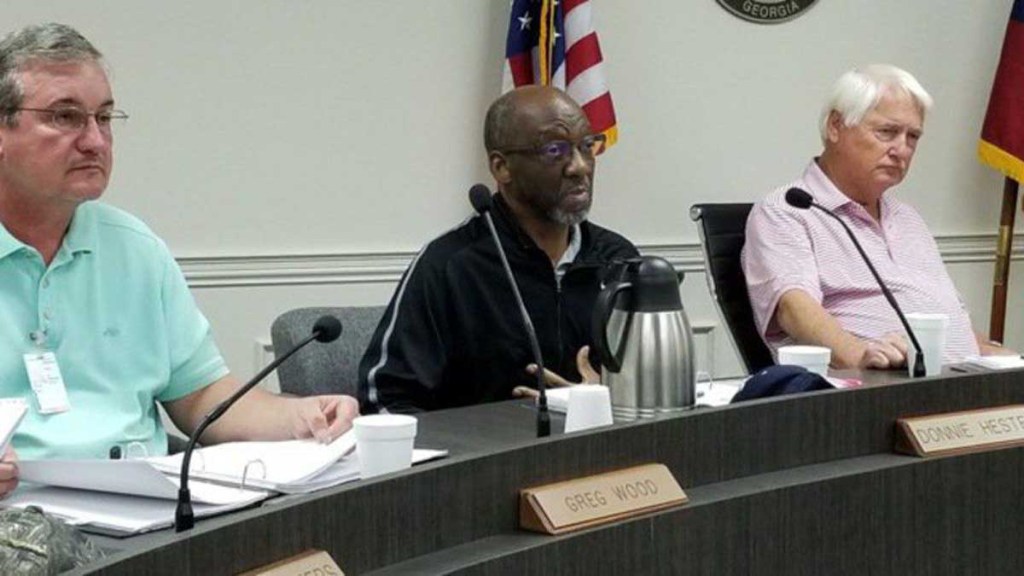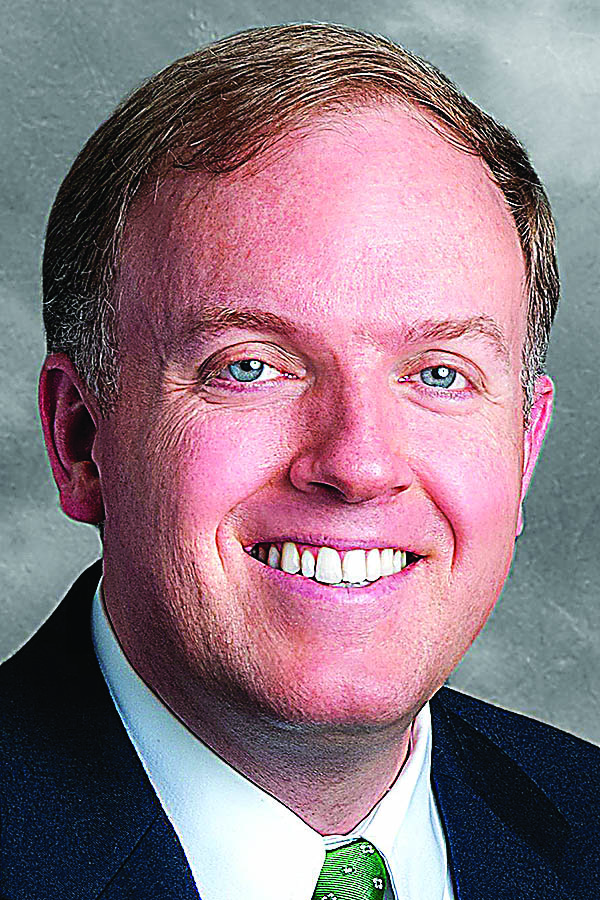Matters of the Heart: Cardiovascular disease prevalent
Published 4:00 am Sunday, February 25, 2018

- Stuart Taylor | The Tifton GazetteDonnie Hester, center, is welcomed back to his seat on the Tift County Board of Commissioners after his surgery.
VALDOSTA – The heart is the engine that drives the body.
When a car engine starts having issues, it need a diagnosis to determine what’s going wrong. The same can be said of the heart.
A sputtering heart could mean clogged arteries, abnormal rhythms, high blood pressure, high cholesterol or a myriad of issues that range from minor to life threatening.
Thousands of people go to the hospital every year for cardiovascular-related illnesses in the SunLight Project area of Valdosta, Thomasville, Moultrie, Dalton, Tifton and Milledgeville, Ga., and Live Oak, Fla.
At the Archbold Memorial Hospital in Thomasville, Archbold’s Loudermilk Heart and Vascular Center catheterization lab performs more than 1,000 catheterizations each year.
Catheterization is the process of using a long, thin tube called a catheter, to diagnose or treat cardiovascular conditions.
In 2015, the lab performed the procedures on 742 males, and 539 females for a total of 1,281 people, according to the hospital. In 2016, the lab performed the procedures on 752 males, and 546 females for a total of 1,298. In 2017, the lab performed heart catheters on 867 males and 585 females for a total of 1,452.
The Tift Regional Health System saw 1,181 people in 2017, according to the hospital. The demographics of visits were broken down as follows:
• White: 926
• Black: 231
• Multi-racial: 21
• American Indian/Alaska Native: 3
• Male: 653
• Female: 528
South Georgia Medical Center in Valdosta performed 177 heart and valve surgeries in 2014, according to the hospital. In 2015, there were 287 total surgeries. In 2016, there were 249 total surgeries performed.
And like an engine, heart problems can crop up at any time, and sometimes with few prior symptoms.
Stressing the Heart
Chris Mohr, 64, of Thomasville and her granddaughter were en route to Savannah in November 2015 when Mohr, who was driving, had a heart attack.
“We had just left Valdosta, hadn’t gotten very far,” Mohr said. “I felt this extreme pressure in my chest. I had a hard time breathing.”
A deep ache began in her left arm.
She considered returning to Thomasville, but the trip to her granddaughter’s college open house was too important to turn back.
Mohr, who is the Thomasville Times-Enterprise general manager, met her daughter in Savannah. The symptoms returned.
“I climbed stairs,” Mohr said. “I did all the wrong things.”
She went to a Savannah hospital emergency room, where an electrocardiogram showed irregularities. Mohr was told she should be admitted to the hospital. She refused, returned to Thomasville the next day, a Sunday, and went to work Monday.
That same Monday she saw her Thomasville physician. Forty-five seconds into a stress test, Mohr’s doctor put her in a wheelchair and took her to the nearby Archbold Memorial Hospital emergency room.
A heart attack was confirmed, and Mohr was hospitalized, she said. She had no previous signs of a heart problem.
However, Mohr was under a tremendous amount of stress: Her father had died, and her mother had been diagnosed with cancer and was under Mohr’s care. She had been transferred in her work.
Today, Mohr is conscious of stress levels. Her diet is better and she exercises.
She married Michael Mohr in August 2016 — a union Mohr said has significantly reduced her stress level.
“I have to take five pills a day now to keep my heart healthy and will have to the rest of my life,” Mohr said.
The stress and resulting heart attack taught her a lesson.
“I don’t try to do it all anymore,” she said.
Defining Heart Attack
Dr. Anil Puri, a pulmonologist in Milledgeville at Navicent Health Baldwin Hospital who also practices critical-care medicine, internal medicine and sleep medicine, spoke about what causes a heart attack.
“Heart attacks are generally caused by blockages in the arteries that leave the heart, what we call the coronary arteries,” Puri said. “Blockage in those arteries leads to a decrease, or lack of blood flow to the muscle of the heart, and then the muscle of the heart starts to die.”
There are modifiable and non-modifiable risk factors when it comes to heart disease. Modifiable risk factors, are things in a person’s life they have control over, or can be modified.
“The main risk factors for heart disease are usually things like smoking, diabetes, high blood pressure and high cholesterol and obesity,” Puri said. “Those would be the most modifiable factors that people should go to their doctor’s office to get checked out for.”
Non-modifiable risk factors are things a person cannot change such as age and family history.
“Genetics absolutely is a factor,” Puri said. “Age, genetics and race can be factors. Of course, those are not modifiable factors, so from a prevention standpoint, there’s not much you can do about those.”
Heart of Genetics
For Dalton resident Phil Noles, heart issues run in the family.
“Heart disease runs in my family,” Noles said. “My father died of a heart attack when he was 54.”
With that knowledge, Noles acted preemptively to try and prevent heart issues.
“When I reached my 50s, I started making an extra effort to live a healthy life,” Noles said. “A month before my 54th birthday, my chest started hurting. I thought it was just a pulled muscle, but after describing my symptoms to a friend, she said, ‘You’re having a heart attack.’ I didn’t believe it, but I went to Hamilton Medical Center’s emergency department just to make sure.”
Dr. Gary Olson of Hamilton Physician Group-Cardiology performed a stress test and heart catheterization, Noles said. Olson found two blockages, and Dr. Eric Guerra, also of Hamilton Physician Group-Cardiology, inserted two stents to restore blood flow.
“After the procedure, I was able to breathe again,” Noles said. “I hadn’t been able to breathe that well in years. After a short recovery, I began attending classes through Hamilton’s cardiac rehabilitation program. I graduated from the program in December of last year and I now exercise three times a week.”
In Noles’ case, genetics was a factor. For others that are not predisposed to heart diseases, modifiable risk factors can’t be mitigated or removed through a change in lifestyle.
“The recognition that (people) have lifestyle factors that are modifiable and that they’re interested in modifying is probably the biggest first step,” Puri said. “Once they feel like that’s something they want to do, meeting with a health-care provider and discussing and developing a plan of action — actually trying to lose weight, something to help them stop smoking, checking their cholesterol. Either educating themselves on a low-cholesterol diet, or a low-salt diet if their blood pressure is high— these are all good things that can be done.”
Knowing the Symptoms
But even if a resident has adapted to a lifestyle, knowing the symptoms of a heart attack is life-saving knowledge.
“I think probably the most obvious sign would be chest pain, particularly in the center of the chest … or on the left side of the chest,” Puri said. “Any pain that radiates into the neck or into the left area. If someone has sudden onset of feeling faint or breaking out into a sweat or feels nauseated … Particularly if symptoms seem to be worsened when the patient exerts themselves.”
Other signs aren’t so obvious but can be noticed during a period of time, said Dr. William Luke, an interventional cardiologist in Valdosta.
New developments of chest discomfort, particularly exertional chest discomfort, can be warning signs, Luke said. Exertional chest pain is pain as a result of exerting effort, such as lifting heavy objects.
A recent reduction of exercise capacity is a warning sign as well, Luke said. Which may manifest itself via exertional shortness of breath or being easily fatigued.
Luke advises patients to be in touch with their state of wellness. Most patients are generally aware of when some sort of change happens in their body, and those changes could be early warning signs that something is wrong.
“Asking our patients to not minimize or overlook a change in how they feel is always important,” Luke said.
Luke said to exercise regularly and use it as a litmus test as far as what your physical expectations should be.
“In 30 minutes, if you walked a mile in 30 minutes, and you did it effortlessly, and now you are walking 15, 20 minutes, and now you are short of breath, that is definitely a warning sign and you should seek professional medical attention,” he said.
Jackie Devane, 64, had noticed slight changes in what she was capable of doing for a several years, but attributed it to age and diabetes.
In late October, early November, Devane was doing yard work when she lifted a rock and turned it over.
About a week later, she started to have pains, she said. Devane assumed the pain was soreness from moving the rock.
“I thought it was me lifting a lot outside,” she said. “Down across my chest to the other side and down my side, there was pain. I went to the hospital and they told me I had a heart attack. … I’d been feeling light headed and dizzy for a few years. I thought it was my sugar diabetes or something.”
On Nov. 6, 2017, Devane went to South Georgia Medical Center. The doctors performed a triple-bypass surgery to help Devane get back on track.
“It was a little bit on the scary side” she said. “I just didn’t know what was going to happen. I thought it was little bit of soreness. Really, the scariest problem I had was when I got out of the surgery, I couldn’t move. They had me paralyzed. They did that I reckon to keep me from moving and all.”
She was released from the hospital Nov. 15, 2017.
Devane continued going to the hospital’s rehabilitation center after she was released to walk on a treadmill and ride a stationary bicycle, she said.
Now that Devane is out of the hospital, she walks regularly and feels much better.
“After I got out of there, I have so much energy now. I don’t know what to do with myself,” she said.
Change of Heart
Ultimately, changing one’s lifestyle can help prevent or minimize heart disease throughout the SunLight Project area of Valdosta, Thomasville, Moultrie, Dalton, Tifton and Milledgeville, Ga., and Live Oak, Fla. The changes that can be made include exercise regularly, eat well and cut extraneous bad habits such as tobacco and alcohol abuse.
For exercise, Dr. William Luke of Valdosta recommends routine aerobic exercise for at least 30 minutes, five days a week.
“What I would consider routine aerobic exercise is walking around your neighborhood,” Luke said.
Knowing what to eat is an important part of how to have a healthy heart.
“We are a reflection of what we eat,” said Dr. Eric Guerra, Hamilton Physician Group-Cardiology. “We need to eat a healthy diet. That means plenty of vegetables, more fruits. The meat we eat should be lean — chicken, fish, turkey.
“When I talk about fish, I don’t mean catfish but salmon, tilapia and fish like that. We need to exercise regularly and keep our weight under control.
“We need to make sure our blood pressure is good. If you have diabetes, you need to keep that under control. Eating a healthy diet will help with that. We need to keep our cholesterol under control.”
Dr. Anil Puri, pulmonologist in Milledgeville at Navicent Health Baldwin Hospital, gave a description of what not to eat.
“Generally speaking, the foods that would be high in what we call saturated fats,” Puri said. “The foods that are high in cholesterol … put you at a higher risk for high cholesterol. Foods that are rich in sodium can elevate one’s blood pressure. Generally speaking, foods that may be high in sugars can lead to weight gain. Those can also be a problem.”
Exercise and eating healthy can help mitigate heart health issues, but having a primary physician that one meets with regularly can go a long way.
“I don’t think there’s any definitive recommendation, like you know, on your 50th birthday, you should go and get checked out … I think, generally speaking, what I would say is folks are never too young to keep tabs on their weight and their blood pressure, blood sugar and cholesterol,” Puri said.
For Luke, seeing his patients regularly builds a sense of accountability, he said.
When a patient sets a goal to lose weight, eat better, exercise more or to quit smoking, and they come in for a regular appointment, it gives Luke the chance to ask about the patient’s progress.
And while not every check-up has a positive response, Luke related it to a report card from school, he said. How a student wants to make their parents feel when they come home with a progress report.
“It’s the same for me when I check their cholesterol, when I ask them if they’ve quit smoking or lost weight,” Luke said. “They are excited to share that news, or the positive lifestyle changes they have made.”
Having Heart Attacks
For Donnie Hester, a Tift county commissioner, began having chest pains while he was singing at a Watch Night Service on New Year’s Eve.
“I started feeling pain coming straight down,” he said, tracing a line down his chest.
A nurse attending the service checked his blood pressure, which was high. By the time 911 was called and Tift County EMS arrived, his blood pressure bottomed out and Hester was transported to the hospital.
“When you’re not educated enough to know what’s going on and what the warning signs are, you don’t know,” Hester said. “I didn’t know. The next day, the doctor came to me and said, ‘You’ve been having heart attacks.’”
By Jan. 3, Hester was undergoing open-heart surgery.
“It was four and a half hours,” he said, referring to the length of the surgery, which ended up being a quadruple bypass.
Hester kept saying he didn’t know the warning signs.
“I just didn’t know,” he said. “I’d be washing my car and be short of breath and I’d think that I was just tired. I’d wake up hot and think I was having hot flashes or something. I just didn’t know.”
He strongly advocates people educating themselves about what the warning signs for a heart attack are and not brushing off heart-related issues.
“You don’t have to be old,” he said. “I never had heart problems. I’d never been sick.”
He had been having problems with high blood pressure, but he had been taken off that medication because he’d been doing well. He doesn’t smoke or drink, and said he never ate a lot of bad foods.
He is going to start walking and exercising more, but he said he should be doing better than he was before, and said he plans on running for reelection this year.
“The heart is a main thing,” he said. “If I’d have gone home that night, I might have had a major heart attack and I’d have been gone.”
He said he is very thankful the doctors, nurses and EMTs were there and able to help him, and thanked God for putting them where they were.
Hester said he wants to donate more time to the American Heart Association’s efforts in the future.
“People have been talking about this for years,” he said. “People don’t change until they’re personally affected.”
The SunLight Project team of journalists who contributed to this report includes Jason A. Smith, Charles Oliver, Patti Dozier, Eve Guevara and Will Woolever. Editors Jim Zachary and Dean Poling edit and coordinate the SunLight Project.
Jason Smith is a reporter at The Valdosta Daily Times. He can be contacted at 229-244-3400 ext.1257.





